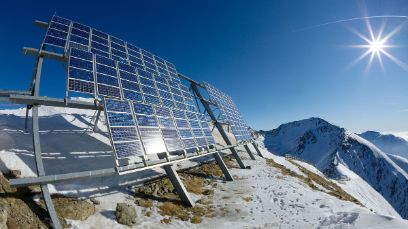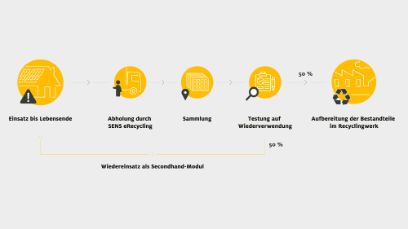- News
A second life for photovoltaic modules
18.10.2023 SENS eRecycling and Swissolar launch the Swiss PV Circle project together with Bern University of Applied Sciences BFH and other partners from the solar and energy industry. The project develops business models with the aim of establishing the reuse of photovoltaic modules in the Swiss solar industry. The potential for reuse is to be identified at an early stage based on data, which is why the project includes the development of a digital platform.
2022 saw more new photovoltaic systems installed than ever before in Switzerland, up by almost 60% on the previous year. The work of installers now will be felt by the recycling industry in roughly 20 to 25 years’ time, when the photovoltaic modules will have reached the end of their life cycle. What many don’t know is that around half of these scrapped photovoltaic modules would perform well enough to continue being used as second-hand modules. This was confirmed in the findings of Bern University of Applied Sciences BFH in the EU Horizon project CIRCUSOL. Photovoltaic modules only lose approximately 0.5% of their output each year and thus still deliver 90% of their original output after 20 years. However, there are various reasons for having to decommission photovoltaic modules. Besides weather damage from hail for example, technical advancement, of course, also plays a role: new photovoltaic modules often deliver much more power than those installed on roofs and façades 20 years ago.

Swiss PV Circle: the project idea
SENS eRecycling, Swissolar and Bern University of Applied Sciences BFH launched the Swiss PV Circle project together with other partners from the solar and energy industry in order to close cycles in the solar industry and thus conserve resources. The aim of the project is to extend the life of photovoltaic modules by developing business models for their reuse. To this end, a platform will be developed, enabling the relevant circulation strategy to be identified at an early stage by way of comprehensive data management. This data-based calculation is to be supported by a standardised test procedure which determines the reuse potential of photovoltaic modules. In this way, tested second-hand modules can be offered on the market at a lower price, with only the modules that are no longer working being recycled. Potential for reuse is to be identified in the project by way of market analysis. One idea is to use second-hand modules where financial resources are lacking.

Project partners involved
Alongside the School of Engineering and Computer Science of Bern University of Applied Sciences BFH, Swissolar and SENS eRecycling, other companies from the Swiss solar and energy industry are also taking part in the Swiss PV Circle project. The two producers of photovoltaic modules Meyer Burger Technology AG and 3S Swiss Solar Solutions AG are involved on the manufacturing side. Helion Energy AG and CKW AG have come on board for the installation and operation of the photovoltaic systems. And finally, the two companies specialising in the recycling of photovoltaic modules KWB Planreal AG from Switzerland and Reiling PV-Recycling GmbH & Co. KG from Germany are also participating. The project is part funded and supported by the Swiss Federal Office of Energy.
Work packages of Swiss PV Circle
Swiss PV Circle consists of seven work packages. A central database in work package 1 serves as the basis for the reuse business models. This will collect data about the photovoltaic modules used in Switzerland and make it available to partners involved in the project. Work package 2 is dedicated to developing business models in the area of recycling and investigates their feasibility, profitability and sustainability. It also involves ensuring the necessary infrastructure for proper removal, storage of the photovoltaic modules and testing. Labelling the modules accordingly for second use is also planned. Forecasts of the volumes of photovoltaic modules, which have gone through their first life cycle, are developed, calculated and visualised in work package 3. Work package 4 is dedicated to tracking the modules along their life cycle. This involves developing the basis for tracking and creating the conditions for separate waste streams. Safe reinstallation of the second-hand modules must also be ensured. Work package 5, therefore, examines options for a profitable resale. A market analysis will identify where the tested second-hand modules can be recirculated. Work package 6 compiles policy-related recommendations for action to improve the legal framework conditions for reusing photovoltaic modules, and work package 7 ensures the communication and diffusion of the findings from the Swiss PV Circle project.